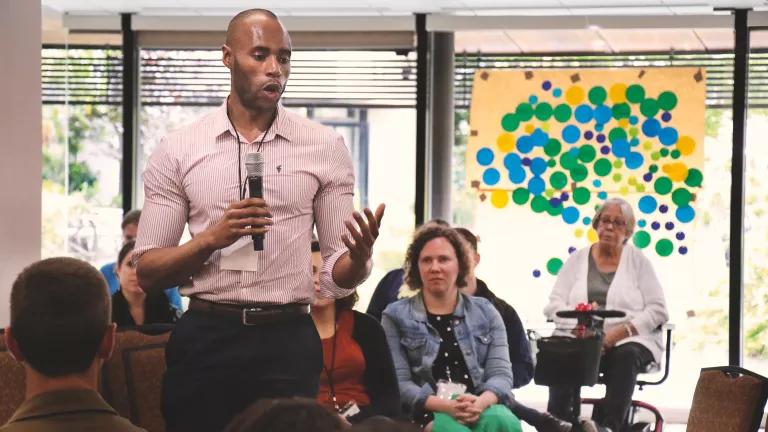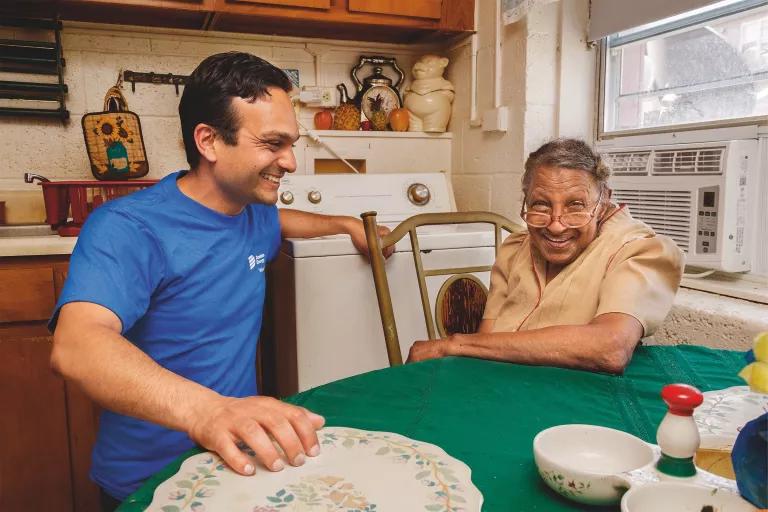Defender of Energy Efficiency—and Equity
Dawone Robinson, regional director of NRDC’s Energy Efficiency for All Project, works to create opportunities for low-income communities of color to save energy and money.

Robinson speaking at an annual meeting of the Network for Energy, Water, and Health in Affordable Buildings, Los Angeles
Dawone Robinson, an energy efficiency advocate in NRDC’s Healthy People & Thriving Communities program, directs the Northeast and Mid-Atlantic regions of Energy Efficiency for All (EEFA). EEFA builds power to change policies and practices by seeding and supporting coalitions in 12 states. National partners collaborate with local and state coalition allies and partners to make multifamily affordable homes energy and water efficient. EEFA’s national partners include NRDC, Elevate Energy, the Energy Foundation, and the National Housing Trust.
Why are some communities unable to take advantage of energy efficiency opportunities?
I think if you were to ask the average person to close their eyes and think about how we can deliver energy efficiency programs to a family, they’ll picture mostly single-family home improvements, like adding attic insulation or sealing ductwork. This tendency to overlook residents of multifamily buildings is also true of policymakers and utilities. These residents have little incentive to invest in long-term energy efficiency upgrades themselves, and property owners often lack incentives as well, especially in cases where tenants pay their own energy bills. This “split incentive” challenge is a barrier to progress. The result is that low-income households and renters are left behind.
How does this inequity impact energy costs?
We partnered with the American Council for an Energy-Efficient Economy to look at energy costs for families in the 50 largest cities in the United States and found that renters pay more for energy as a percentage of their income than homeowners do. Low-income families pay more than your average family, and people of color pay more than white households across the board, even if you control for the size of the home. So for the equivalent square footage, people of color pay more, low-income families pay more, renters pay more. Now, why is that? The reason is the quality of the housing stock. These homes are generally leaky; they’re older and run-down. They’re inefficient, so people are paying more money in homes that are less comfortable. That’s an injustice we need to help solve.
How is EEFA helping to bridge this gap?
We’re still dealing with a huge disparity in the amount of resources that are actually going to the multifamily housing sector. Nevertheless, we do have some cases where we’ve been able to work with utilities to provide a pretty large sum of money for lower-income people and people in multifamily housing. In Virginia, our state multifamily energy efficiency coalition worked directly with the largest utility, Dominion Energy, through a shareholder-funded program to dedicate about $140 million over the course of 10 years for low-income weatherization, other upgrades, and some bill-paying assistance. The majority of that money has gone to multifamily housing.

How can policymakers help address this disparity?
More than half of the nation’s states have mandatory energy efficiency savings targets—the state or the utilities have to save a certain percentage of energy every year through efficiency measures. But how much of those energy savings is being achieved in low-income housing? Usually not much. We need to have equity-first energy policies that prioritize the needs of low-income families of color who are hit the hardest. That’s number one. On the federal level, we need to fight to both preserve and increase funding to vital programs, including the Low Income Home Energy Assistance Program and the Weatherization Assistance Program. These resources are funded back down to the states to go toward weatherization and other heating and cooling assistance for low-income families.
And utility programs need to get more creative. Instead of thinking about renewable energy and energy efficiency in a single box, put energy efficiency first. There’s a saying that the cheapest energy is the energy we don’t use. If we were just smarter about the way we used our current energy resources—if our homes and our appliances were more efficient—then we wouldn’t need to build more power plants.
How do you hope to see EEFA ramp up in the coming years?
We host a lot of energy equity forums; some past events have been in Columbus, Georgia (organized by EEFA Georgia); Detroit (organized by Michigan Energy Efficiency for All); Baltimore (organized by Energy Efficient Maryland); and Norfolk, Virginia (organized by the Virginia Multifamily Energy Efficiency Coalition). We use them to explain to community members why their energy bills are as high as they are and what they can do about it. We offer people practical, DIY suggestions to make their home energy efficient and to ensure that their home is healthy, from making basic ceiling improvements to swapping out old incandescent bulbs for LED light bulbs. We’ve even had utilities show up and do outreach about programs they offer. That’s been very successful, and I hope to do more of those events. We’ve built a lot of connections with local officials and with utilities. We don’t need to be adversarial with all utilities. Sometimes we can partner up, connect people with the programs they need, and just do good community service.
This NRDC.org story is available for online republication by news media outlets or nonprofits under these conditions: The writer(s) must be credited with a byline; you must note prominently that the story was originally published by NRDC.org and link to the original; the story cannot be edited (beyond simple things such as grammar); you can’t resell the story in any form or grant republishing rights to other outlets; you can’t republish our material wholesale or automatically—you need to select stories individually; you can’t republish the photos or graphics on our site without specific permission; you should drop us a note to let us know when you’ve used one of our stories.
Sharing the Road: Safer Streets Means Safe for Everyone
Justice Warrior on the Affordable Energy Front
An Advocate for Building Equity into Michigan’s Climate Goals
Sharing the Road: Safer Streets Means Safe for Everyone
Justice Warrior on the Affordable Energy Front
An Advocate for Building Equity into Michigan’s Climate Goals
Sharing the Road: Safer Streets Means Safe for Everyone
Justice Warrior on the Affordable Energy Front
An Advocate for Building Equity into Michigan’s Climate Goals
Sharing the Road: Safer Streets Means Safe for Everyone
Justice Warrior on the Affordable Energy Front